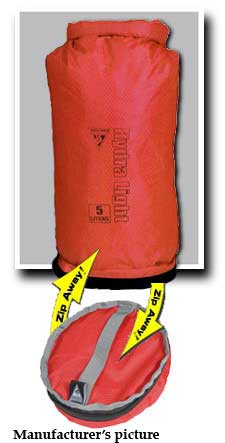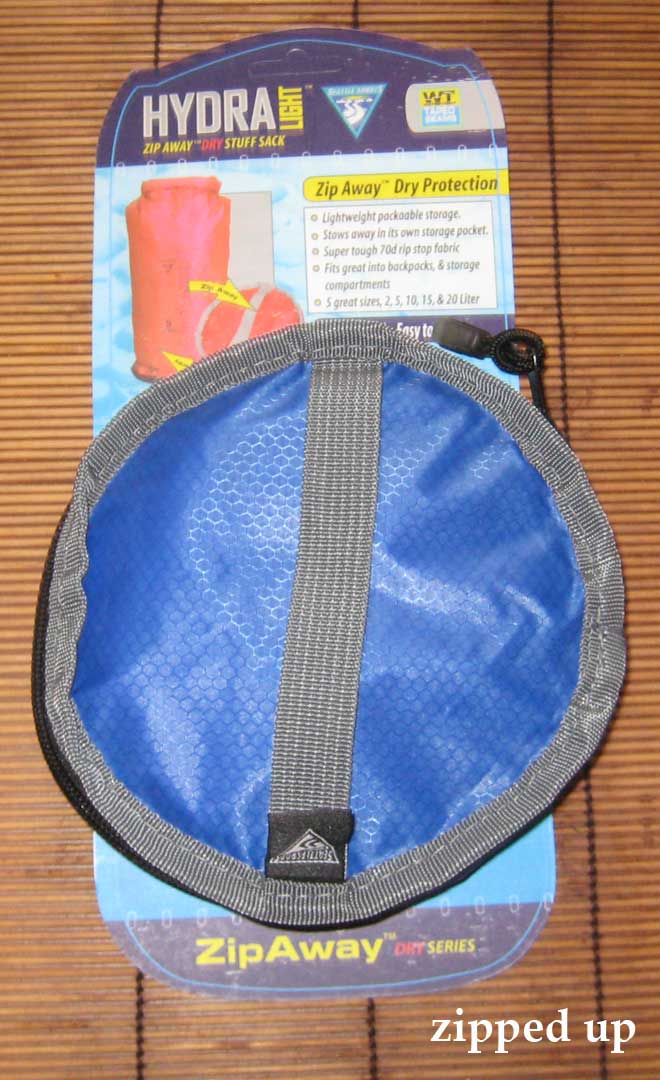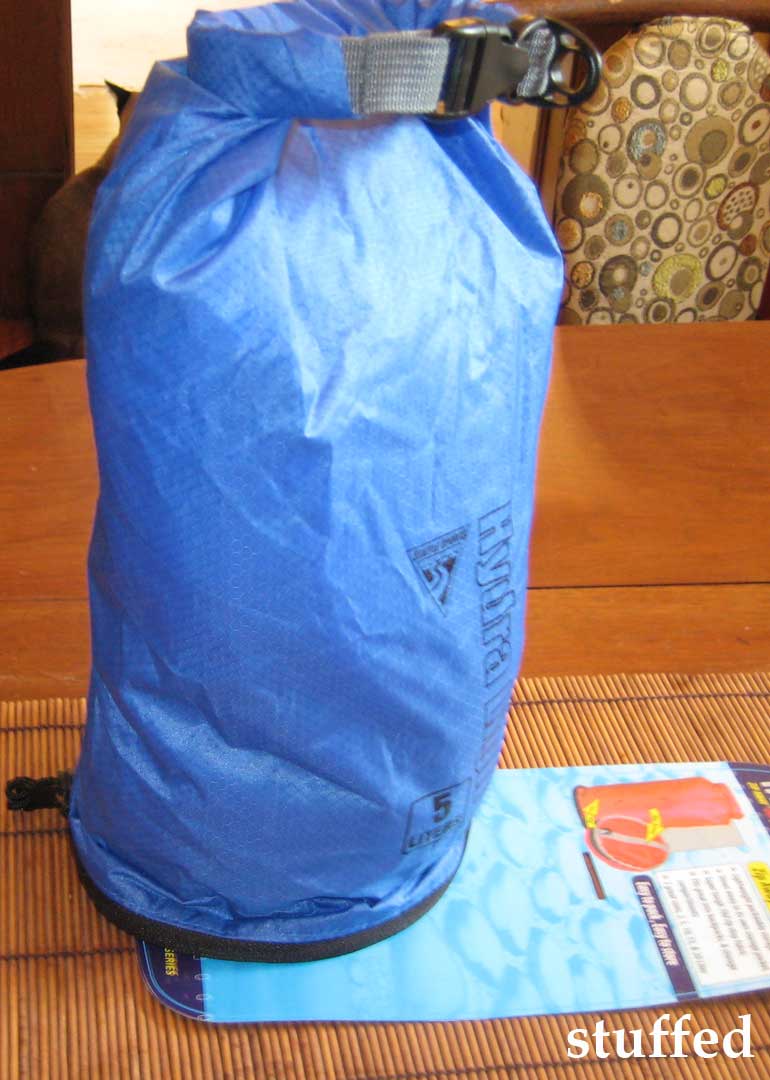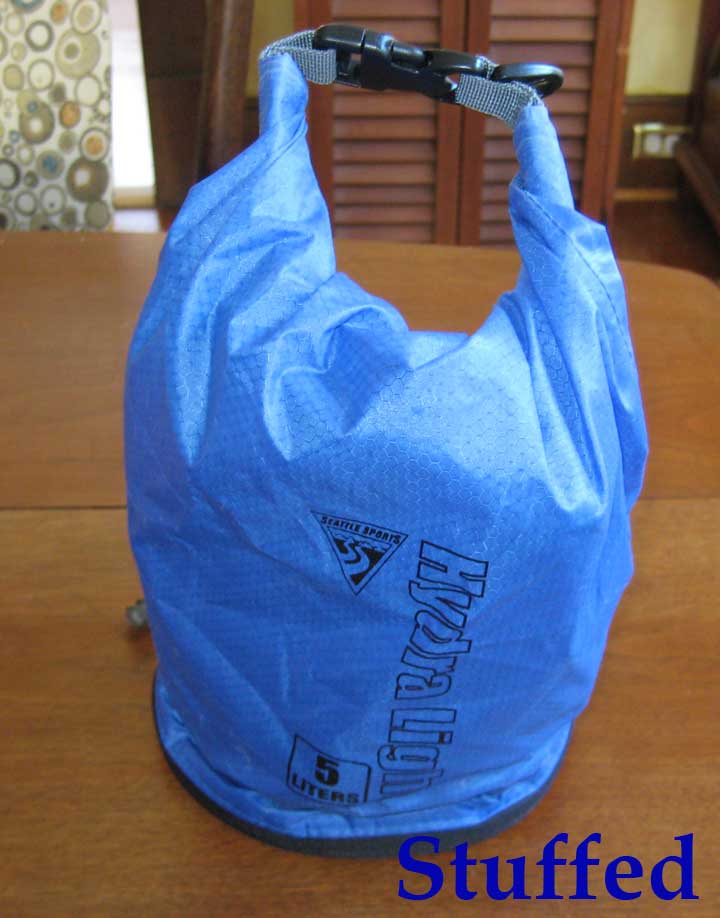

 |
 |
 |
Guest - Not logged in | |||
Reviews > Stuff Sacks > Dry Bags > Seattle Sports Hydralight Zip Away > Test Report by Dawn Larsen
Seattle Sports Hydralight Zip
Away Dry Stuff Sack
Age: 48 Gender: female Height: 5' 4" (163 cm) Weight: 165 lb (74 kg) Email address: vicioushillbilly AT yahoo DOT com Florence, South Carolina USA Date: 26 September 2008 Initial Report Backpacking Background: I used to backpack in college a zillion years ago and just recently (in the last year) backpacked some private trails twice in Tennessee. I have been an avid car-camper for ten years and I have kayak/canoe camped for three years, both mostly in Tennessee, Missouri and Arkansas. I use a lot of the same equipment for both. I hike hilly/rocky trails especially in Tennessee and Missouri. I just moved to South Carolina and am planning to check out the terrain here with my fifteen year-old son. Product Information Manufacturer: Seattle Sports Year of Manufacture: unknown URL: www.seattlesportsco.com Manufacturer's measurements: 11" (279 mm) height by 6" (152 mm) diameter, 305 cu. in (5 L) Actual measurements not stuffed and unrolled flat: 17.25" (438 mm) by 6" (152 mm) diameter Listed weight: 2.2 oz (62 g) Weight as delivered: 2.2 oz (62 g) Manufacturer's Suggested Retail Price: web says $7.95 and add $3.00 for the 5 L size. 
Product description It came zipped up on a card with information, but no instructions although it doesn't really need any. It has a picture that showed me how to zip and open. It zips inside of itself. I had ridden my bike to work that day so I unfolded it and stuffed it with bike essentials (first aid kit, reflectors, tape, etc.) and stuffed it in my bike basket. Worked fine. It is light, a little stiff, but that is probably because of the rip-stop fabric. I did have some trouble zipping it back up into itself to take the zipped picture. The zipper kept hanging on the material. The main concern is its durability.  
Field Information Generally, my son and I camp and kayak in and around Florence, South Carolina. I also ride my bike to work 3-4 days per week, rain or shine, and use stuff sacks in my panniers to organize my things. I also travel by train, plane, car with a backpack instead of a suitcase most of the time and use stuff sacks to organize my things. It has been raining like crazy in South Carolina this fall. We have planned the following trips for the fall: 1. Car camping in Columbia, South Carolina at Dreher Island State Park October 24-25. South Carolina can be boiling in October with temperatures generally falling in the 90 - 100 degree F (32-38 degrees C) range during the day and 70-80 degree F (21-27 degrees C) range at night; or mild 70 degrees F (21 degrees C) during the day to mid-50s degrees F (mid-10 degrees C) at night. The weather changes at a moment's notice. It may rain or be hot and dry. We have to pack for all kinds of weather. The soil is sandy and this particular park sits in the middle of a large lake so it is very windy. We will bring our kayaks and be on the water every day. It is always humid, especially on a lakeshore. 2. Train trip to Charleston, South Carolina October 3-6. I will be staying in a hotel, but traveling by train with my backpack. I use stuff sacks to organize my things in my large pack and even in my daypack if they are small. Charleston weather is humid and windy since it is on the coast. Temperatures range from 70-90 degrees F (21-32 degrees C) during the day to 60-70 degrees F (15-21 degrees C) at night. 3. I belong to a group of kayakers called the Sumter Hiking, Cycling and Adventure Club. We paddle and camp at the spur of the moment. So if someone posts a trip on the website, we very often join them. Usually it is around Sumter, South Carolina. Conditions there are much like those in #1. 4. I ride my bike to work at least 3 days per week, a little over 8 miles (13 k) one way. I jam full stuff sacks in my soft messenger bag that I strap on a bike rack and into my panniers. I ride rain or shine, so dry sacks are a must. I ride half way on a side street and then half way on the shoulder of a major four-lane highway. There is a lot of road dirt, grime, and dust that gets into my pannier, which is really a wire basket with stuff sacks jammed in it. The sacks are packed with various things from clothing to harder objects like my billfold, power cord for my computer, etc. There may be other trips this fall and early winter, as well. After September, all car camping (every couple of weekends) will be in South Carolina, most likely in state parks. We especially like to camp in the fall when the weather is cooler. We also plan to do a beach camp on a weekend. Backpacking trips may crop up from time to time. I hope to backpack a couple of South Carolina trails in the fall. Temperature in South Carolina rarely gets below 50 degrees F (10 degrees C) at night or above 80 degrees F (26 degrees C) during the day in the late fall and early winter. It is in January and February, when temps fall below 40 degree F at night. Strategy: My strategy is to handle these stuff sacks roughly just like I do the sacks I own. I am really hard on stuff sacks and they end up tearing at the seams or cracking (if coated with waterproof material). I'll be testing for the following: Durability - Will the sack stay together? Will it split at the seams? Is the overall material rugged and durable? Will the zippered bottom break, snag, be a pain? Though one of the main features of this sack is that it is supposed to pack away into itself, is that zipper going to be more trouble than it's worth as far as cramming it into a backpack or pannier? Pack away - Will that zipper be a problem if I want to cram it inside something to pack it away when there is nothing in the sack? Weight - Is it light enough to organize my backpack when I want to backpack with it? Waterproof - Does it keep the road grime and rain off my stuff? Thanks to Seattle Sports for providing this Hydralight ZipAway! Dry Stuff Sack for testing. Check back in two months for more information from the field.
7 December 2008
Field Conditions and Trips I ride my bike to work at least 3 days per week, a little over 8 miles (13 k) one way. I jammed this full stuff sack in into my pannier, which is really a wire basket that I strapped to my rear rack. I used this stuff sack to store things that I needed immediately, such as: billfold, sunglasses, keys, first aid kit, lip gloss, lights, etc. It is sort of like my "purse on wheels." I usually put my keys in the zipper compartment the sack is supposed to store in. I did have to use smaller stuff sacks for the smaller items so they wouldn't slide to the bottom. See the pictures below. I ride rain or shine, so dry sacks are a must. I ride half way on a side street and then half way on the shoulder of a major four-lane highway. There is a lot of road dirt, grime, and dust that gets into my pannier.  
10/25/08 Camped on private land in South Carolina for the weekend, Friday night through Sunday morning. It was temperate, mid 70s degree F (mid 20s C) during the day and 45 degrees F (7 C) at night. I used the Hydralight to keep my underwear in. It stayed in the tent, in or out of my pack. 10/3-6/08 Train trip to Charleston, South Carolina. I stayed in a hotel, but traveled by train with my backpack. I used stuff sacks to organize my things in my large pack and even in my daypack if they are small. Charleston weather is humid and windy since it is on the coast. Temperatures range from 70-90 degrees F (21-32 degrees C) during the day to 60-70 degrees F (15-21 degrees C) at night. 10/10/08 Short kayaking trip on a private lake in South Carolina. This was an hour of paddling around. Temperature was about 65 degrees F (18 C) and clear. Again, I used this as my "purse" to hold smaller items. It did not fall in. I was nervous because it does not hold air, so does not float. What I've Found So Far I really love this sack especially for biking. I looking forward to using it on my backpack trip in December as my "pack safe" since it has worked so well for that on my bike. Durability – So far I have found it to be very durable. I have totally abused it on my bike rides. It has held together very well under rain and shine. Seams are still together, clasp is holding, zipper is clean. Ease of Use – I really like its design. It is not too long, so I don't have to roll it up so much. That helps when I need to get something out of it quickly. It doesn't, however, hold air, even if I don't roll it tightly, so it is not especially good for kayaking unless I put it in a larger drysack that does hold air. It does not work like a drybag as it would not float on its own. Pack Away – I don't know that I have as yet packed it in itself because I use it so much. When I'm not using it to camp or bike, it hangs on a hook in my kitchen, so I can't speak to this yet. Waterproof – I have ridden in the pouring rain and everything in it stayed completely dry. The sack works very well to keep the road grime off the contents. The zipper compartment that the bag is supposed to store into is not waterproof, however. Things I like so far: 1. Waterproof 2. Lightweight Things I don't like so far: 1. It doesn't float, hold air. 2. I sometimes lose smaller items in the bottom of the sack I have continued to use the Hydralight when hiking and riding my bike. I took it on a cold and humid overnight hike by the Buffalo River in northeast Arkansas. Temperature was about 45 degrees F (7 C) during the day and about 27 degrees F (-3 C) at night. I put my underwear, sleeping socks, sleeping T-shirt, and first aid kit in it. Everything stayed nice and dry. Then, I took it on two day hikes in South Carolina using it as a pack safe (keys, camera, first aid kit, and cell phone), one day wet and the other dry. Temperatures were about 50-55 degrees F (10-13 C) during the day. Again, everything stayed dry. I continue to bike to work, though a little less now that it has turned freakishly cold in South Carolina. However, when it is over 40 degrees F (4 C), I bike. Final Summary I really like this dry bag for hiking and biking. It withstood a lot of rough use in these last two months, especially on my bike where I tend to cram stuff into it and then cram it in a pannier. It is very light and the cloth is thin and pliable, which makes it excellent for stuffing with gear and then stuffing the Hydralight into a backpack or pannier. Because it doesn't hold air well, I doubt that I will use it in a kayak regularly. I might use it on an overnight kayak trip to stuff really important items (underwear, socks, silk sleeping sack) that I want to stay dry and then stuff the bag into a thicker dry bag that will hold air. The seams are still together, it is still waterproof. The zipper still works on the underside of the bag. The clasp has not broken. I think I have decided to use the compartment that is supposed to zip to store the bag as a quick place to put my house keys when I bike to work. The bottom line is that this sack functions primarily as a hiking/biking drybag and not so useful for kayaking. I really do like it for stuffing my essentials when riding my bike and will continue to use it for that purpose. I plan to use it as my "purse" when riding my bike until the Hydralight falls apart. What I like:1. Durable 2. Rainproof 3. Light, pliable material What I didn't like: 1. Not suitable for kayaking because it doesn't hold air well Thanks so much to Seattle Sports and Backpackgeartest.org for the opportunity to test this fine product. This concludes my review of Hydralight Zip Away Dry Stuff Sack. Addendum to Report 7 May 2011 I am SO sorry to report that this stuff sack is NOT waterproof anymore. The test series began at the end of September 2008. I have been using it on average 3 days per week for about 20 weeks per year as my biking "purse" since the test period was over. I have also used it periodically as a pack safe on maybe ten trips including one to Guatemala where it was squished in my backpack repeatedly for about 2 weeks. When biking, I put it in my pannier, which is not waterproof and store my wallet, cell phone, and most of the items that you see in the pictures above. The other day I got caught in a downpour. That was the first time that had happened and I decided to go ahead and ride. 15 minutes later, the stuff sack was soaked and all of my stuff inside was drenched. I let it dry out and held it under running water and the inside of the sack got completely wet in 15 seconds. I am so sorry too because I liked the size. I liked the lightweight material. And I really liked the way it zipped into itself when not in use. As you can see in the picture, the material has changed color, gotten lighter and more "scuffed" and unfortunately, is not waterproof any more.
Read more reviews of Seattle Sports gear Read more gear reviews by Dawn Larsen Reviews > Stuff Sacks > Dry Bags > Seattle Sports Hydralight Zip Away > Test Report by Dawn Larsen | ||||